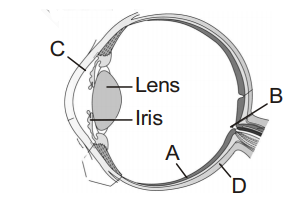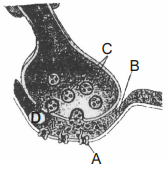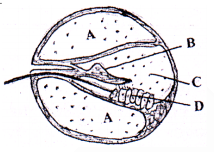Cytoplasm with typical cell organelles and Nissl’s granule is present in the
1. Axon Hillock
2. Cell body
3. Axon
4. Synaptic vesicles
Multipolar neurons are found in the
1. Retina of eye
2. Embryonic stage
3. Both (1) & (2)
4. Cerebral cortex
The ionic gradients across the resting membrane are maintained by the
1. Ion channels
2. Sodium-potassium pumps
3. Electrical synapses
4. Chemical synapses
On application of a stimulus on the axonal membrane,
1. There is a rapid influx of K+ at that site
2. There is a rapid efflux of Na+ at that site
3. There is a rapid influx of Na+ at that site
4. There is a rapid efflux of K+ at that site
Which of the following meninges is in contact with the brain tissue?
1. Duramater
2. Arachnoid
3. Piamater
4. No meninx is in contact with the brain tissue
The association areas are present in the
1. Cerebral cortex
2. Corpus callosum
3. Amygdala
4. Hypothalamus
The limbic system is formed by
1. The hypothalamus, epithalamus, amygdala and hippocampus
2. Hypothalamus, amygdala and limbic system
3. Corpora quadrigemina and hippocampus
4. Midbrain and hindbrain
The canal passing through the midbrain is called
1. Medulla oblongata
2. Cerebral aqueduct
3. Eustachian tube
4. Aqueous chamber
Which layer of the wall of eyeball looks bluish in colour?
1. Sclera
2. Cornea
3. Choroid
4. Retina
Eye lens is held in the place by
1. Muscle fibres of iris
2. Ligaments attached to the ciliary body
3. A transparent gel called vitreous humor
4. Thin watery fluid called aqueous humor
The order of three layers of cells in the retina from inside to outside is
1. Bipolar cells Ganglion cells Photoreceptor cells
2. Photoreceptor cells Ganglion cells Bipolar cells
3. Ganglion cells Bipolar cells Photoreceptor cells
4. Photoreceptor cells Bipolar cells Ganglion cells
The retinal blood vessels enter the eye at
1. Fovea
2. Blind spot
3. Macula lutea
4. Crista
Which of the following results in the generation of potential differences in the photoreceptor cells of eyes?
1. Conversion of retinal into opsin
2. Conversion of opsin into retinal
3. Dissociation of the retinal from opsin
4. Dissociation of the opsin from retinol
The eustachian tube connects_____with the _____.
1. External auditory canal, middle ear cavity
2. Middle ear cavity, pharynx
3. External auditory canal, labyrinth
4. Cochlea, larynx
The membranous labyrinth is surrounded by a fluid called
1. Perilymph
2. Endolymph
3. Cerebrospinal fluid
4. Vitreous humor
The lower membrane of the scala vestibuli is the
1. Tympanic membrane
2. Reissner’s membrane
3. Basilar’s membrane
4. Tectorial membrane
The stereo cilia are projected from which part of the hair cell?
1. Basal part
2. Apical part
3. Lateral part
4. Front part
In mammalian eye, the 'fovea' is the center of the visual field, where
1. More rods than cones are found
2. High density of cones occur, but has no rods
3. The optic nerve leaves the eye
4. Only rods are present
A gymnast is able to balance his body upside down even in the total darkness because of
1. Organ of corti
2. Cochlea
3. Vestibular apparatus
4. Tectorial membrane
Which of the following regions of the brain is incorrectly paired with its function?
1. Cerebrum-calculation and contemplation
2. Medulla oblongata-homeostatic control
3. Cerebellum-language comprehension
4. Corpus callosum-communication between the left and the right cerebral cortices
Injury localized to the hypothalamus would most likely disrupt
1. Short-term memory
2. Co-ordination during locomotion
3. Executive functions, such as decision making
4. Regulation of body temperature
Which one of the following statements is not correct?
1. Retinal is the light absorbing portion of visual photo pigments
2. In retina the rods have the photopigment rhodopsin while cones have three different photopigments
3. Retinal is a derivative of Vitamin C
4. Rhodopsin is the purplish red protein present in rods only
Parts A, B, C and D of the human eye are shown in the diagram. Select the option which gives correct identification along with its functions/characteristics:
1. B – Blind spot – has only a few rods and cones.
2. C – Aqueous chamber – reflects the light which does not pass through the lens.
3. D – Choroid – its anterior part forms ciliary body.
4. A – Retina – contains photo receptors – rods and cones.
A diagram showing axon terminal and synapse is given. Identify correctly at least two of A-D.
1. B - Synaptic connection
D - K+
2. A - Neurotransmitter
B - Synaptic cleft
3. C - Neurotransmitter
D - Ca++
4. A - Receptor
C - Synaptic vesicles
The human hind brain comprises three parts, one of which is
1. Cerebellum
2. Hypothalamus
3. Spinal cord
4. Corpus callosum
A person entering an empty room suddenly finds a snake right in front on opening the door. Which one of the following is likely to happen in his neuro-hormonal control system?
1. Sympathetic nervous system is activated releasing epinephrin and norepinephrin from adrenal cortex
2. Sympathetic nervous system is activated releasing epinephrin and norepinephrin from adrenal medulla
3. Neurotransmitters diffuse rapidly across the cleft and transmit a nerve impulse
4. Hypothalamus activates the parasympathetic division of brain
When a neuron is in resting state i.e., not conducting any impulse, the axonal membrane is
1. Comparatively more permeable to K+ ions and nearly impermeable to Na+ ions.
2. Comparatively more permeable to Na+ ions and nearly impermeable to K+ ions
3. Equally permeable to both Na+ and K+ ions
4. Impermeable to both Na+ and K+ ions
The nerve centres which control the body temperature and the urge for eating are contained in
1. Thalamus
2. Hypothalamus
3. Pons
4. Cerebellum
Given below is a diagrammatic cross-section of a single loop of human cochlea. Which one of the following options correctly represents the names of three different parts?
1. A – Perilymph, B – Tectorial membrane, C – Endolymph
2. B – Tectorial membrane, C – Perilymph, D – Secretory cells
3. C – Endolymph, D – Sensory hair cells, A – Serum
4. D – Sensory hair cells, A – Endolymph, B – Tectorial membrane
During the propagation of a nerve impulse, the action potential results from the movement of
1. Na+ ions from extracellular fluid to intracellular fluid
2. K+ ions from extracellular fluid to intracellular fluid
3. Na+ ions from intracellular fluid to extracellular fluid
4. K+ ions from intracellular fluid to extracellular fluid
During the transmission of nerve impulse through a nerve fibre, the potential on the inner side of the plasma membrane has which type of electric charge?
1. First positive, then negative and again back to positive
2. First negative, then positive and again back to negative
3. First positive, then negative and continue to be negative
4. First negative, then positive and continue to be positive.
Which one of the following is an example of negative feed back loop in humans?
1. Secretion of sweat glands and constriction of skin blood vessels when it is too hot.
2. Constriction of skin blood vessels and contraction of skeletal muscles when it is too cold.
3. Secretion of tears after falling of sand particles in to the eye
4. Salivation of mouth at the sight of delicious food.
Bowman’s glands are located in the
1. Olfactory epithelium of our nose
2. Proximal end of uriniferous tubules
3. Anterior pituitary
4. Female reproductive system of cockroach
Which one of the following not act as a neurotransmitter?
1. Acetylcholine
2. Epinephrine
3. Nor epinephrine
4. Cortisone